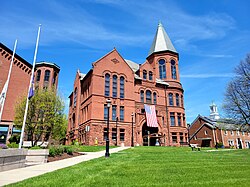
The Grand Army of the Republic (GAR) was a fraternal organization composed of veterans of the Union Army, Union Navy, and the Marines who served in the American Civil War. It was founded in 1866 in Decatur, Illinois, and grew to include hundreds of "posts" across the North and West. It was dissolved in 1956 at the death of its last member, Albert Woolson.

United States Colored Troops (USCT) were Union Army regiments during the American Civil War that primarily comprised African Americans, with soldiers from other ethnic groups also serving in USCT units. Established in response to a demand for more units from Union Army commanders, by the end of the war in 1865 USCT regiments, which numbered 175 in total, constituted about one-tenth of the manpower of the army. Approximately 20% of USCT soldiers were killed in action or died of disease and other causes, a rate about 35% higher than that of white Union troops. Numerous USCT soldiers fought with distinction, with 16 receiving the Medal of Honor. The USCT regiments were precursors to the Buffalo Soldier units which fought in the American Indian Wars.
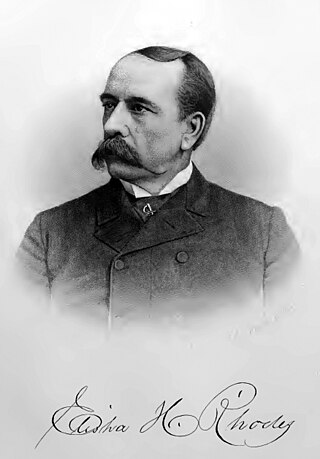
Elisha Hunt Rhodes was an American soldier who served in the Union Army of the Potomac for the entire duration of the American Civil War, rising from corporal to colonel of his regiment by war's end. Rhodes' illustrative diary of his war service was quoted prominently in Ken Burns's 1990 PBS documentary series The Civil War, read by Chris Murney.
The 14th Connecticut Infantry Regiment, also known as the Nutmeg Regiment, was an infantry regiment that participated in the American Civil War. It participated in the Battle of Gettysburg, helping to repulse the Confederate attack on the third day known as Pickett's Charge.
The 8th Missouri Infantry Regiment was an infantry regiment in the Union army during the American Civil War. Among its early leaders were Morgan Lewis Smith and Giles Alexander Smith, both of whom later became generals.

The 5th New York Infantry Regiment, also known as Duryée's Zouaves, was a volunteer infantry regiment of the Union Army during the American Civil War, led by Colonel Abram Duryée. Modeled, like other Union and Confederate infantry regiments, on the French Zouaves of Crimean War fame, its tactics and uniforms were different from those of the standard infantry.

The Colorado Territory was formally created in 1861 shortly before the bombardment of Fort Sumter sparked the American Civil War. Although sentiments were somewhat divided in the early days of the war, Colorado was only marginally a pro-Union territory. Colorado was strategically important to both the Union and Confederacy because of the gold and silver mines there as both sides wanted to use the mineral wealth to help finance the war. The New Mexico Campaign was a military operation conducted by Confederate Brigadier General Henry Sibley to gain control of the Southwest, including the gold fields of Colorado, the mineral-rich territory of Nevada and the ports of California. The campaign was intended as a prelude to an invasion of the Colorado Territory and an attempt to cut the supply lines between California and the rest of the Union. However, the Confederates were defeated at the Battle of Glorieta Pass in New Mexico and were forced to retreat back to Texas, effectively ending the New Mexico Campaign.
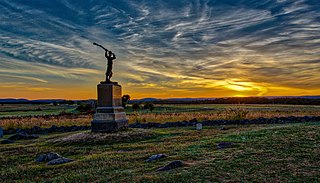
The 72nd Pennsylvania Infantry was a volunteer infantry regiment which served in the Union Army during the American Civil War. It was part of the famous Philadelphia Brigade. They wore a very Americanized zouave uniform, consisting of a zouave jacket trimmed with red without a tombeaux on the jacket, sky-blue trousers with a red stripe down the leg, a sky-blue zouave vest trimmed in red, white gaiters, and a dark blue kepi. The jacket was decorated with 16 ball brass buttons down the front of the jacket, which were not part of the original French Zouave uniform.
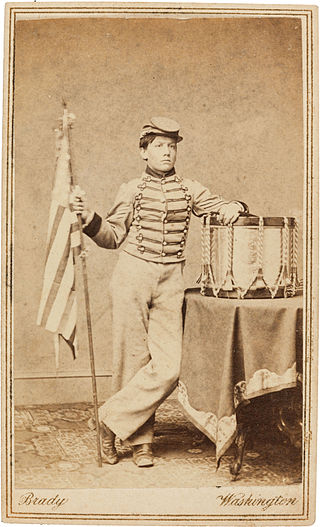
Robert Henry Hendershot, known as the Drummer Boy of the Rappahannock, was an American Civil War drummer boy known for his reputed heroics at the Battle of Fredericksburg, Virginia, in December 1862.

The New England state of Connecticut played an important role in the American Civil War, providing arms, equipment, technology, money, supplies, and manpower for the Union Army, as well as the Union Navy. Several Connecticut politicians played significant roles in the Federal government and helped shape its policies during the war and the subsequent Reconstruction.
New Hampshire in the American Civil War was the story of a small state remote from the battlefield that contributed strongly in terms of soldiers, money and supplies. It sent 31,650 enlisted men and 836 officers, of whom about 20% were killed in action or died from disease or accident.

The present-day state of Nebraska was still a territory of the United States during the American Civil War. It did not achieve statehood until March 1867, two years after the war ended. Nevertheless, the Nebraska Territory contributed significantly to the Union war effort.

The 17th New York Veteran Infantry Regiment was an infantry regiment that served in the United States Army during the American Civil War. It was often referred to as the 17th New York Veteran Zouaves and has been erroneously reported as using mules as mounts during Sherman's March to the Sea up until the Grand Review of the Armies. The regiment wore the Hawkins Zouave pattern uniform, which was first used by the 9th New York Volunteer Infantry, Hawkins Zouaves, and later was adopted by several other regiments including the 164th New York, 35th New Jersey and others.

Richard Willis DeWitt was a Union Army soldier during the American Civil War. He received the Medal of Honor for gallantry during the Siege of Vicksburg on May 22, 1863.
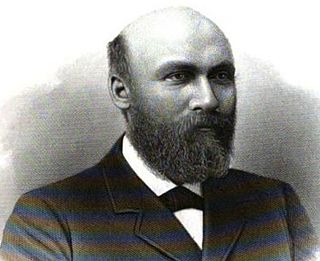
Stephen F. Brown was a Union Army officer in the American Civil War, and became famous for taking part in the Battle of Gettysburg armed only with a camp hatchet.

John Wallace Scott, also known as J. Wallace Scott, was a United States soldier who fought with the Union Army as a member of several Pennsylvania infantry units during the American Civil War. Severely wounded during the Siege of Petersburg in 1864, he was recognized for his meritorious service less than eight months later with his nation's highest award for bravery, the U.S. Medal of Honor, for capturing the enemy's flag while serving as captain of Company D of the 157th Pennsylvania Infantry during the Battle of Five Forks, Virginia on April 1, 1865. That award was conferred on April 27, 1865.

The 47th Pennsylvania Infantry Regiment, which was officially known as the 47th Regiment, Pennsylvania Volunteer Infantry, or more simply as the 47th Pennsylvania Volunteers, was an infantry regiment that served in the Union Army during the American Civil War and the early months of the Reconstruction era. It was formed by adults and teenagers from small towns and larger metropolitan areas in the central, northeastern and southeastern parts of the state.

The Eighth Maine Regiment Memorial, now the 8th Maine Lodge, is a historic summer fraternal meeting house at 13 Eighth Maine Avenue on Peaks Island, an island neighborhood of Portland, Maine. Built in 1891 as a reunion site for veterans of the American Civil War 8th Maine Volunteer Infantry Regiment, it is a fine example of Shingle style architecture, and an important work of the local architectural firm of Fasset and Tompson. It was listed on the National Register of Historic Places in 2006, and presently operates as a summer lodge and museum, with rooms rented to the public.
